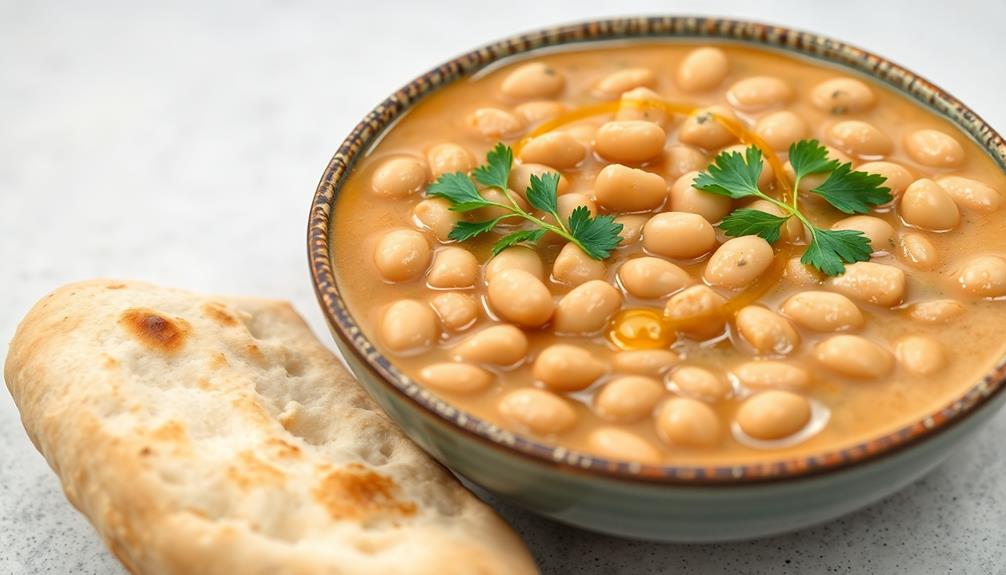Egyptian koshari is a dish shaped by centuries of cultural exchange, evolving from simple street food to a national icon. It reflects influences from the Ottoman Empire, which introduced ingredients like rice, lentils, and pasta, as well as colonial periods that brought spices and imported foods. Over time, koshari incorporated new flavors and techniques, symbolizing Egypt’s resilience and adaptability. If you keep exploring, you’ll discover how this humble dish narrates Egypt’s layered history and diverse heritage.
Key Takeaways
- Koshari originated as a traditional Egyptian street food blending ancient ingredients with Ottoman, Arab, and colonial influences.
- Ottoman rule introduced staples like lentils, rice, and pasta, shaping Koshari’s textures and flavors.
- During British colonization, it became a quick, affordable dish for workers, incorporating Italian pasta and Indian spices.
- Modern variations reflect global culinary trends, blending Italian, Indian, and local flavors, showcasing Egypt’s cultural adaptability.
- Koshari symbolizes Egypt’s rich history of cultural fusion, resilience, and evolving culinary identity through centuries of empire and trade.

Koshari is Egypt’s beloved comfort food, blending a rich history with a mix of flavors that reflect the country’s diverse cultural influences. As you explore its origins, you’ll notice how this hearty dish embodies a culinary fusion shaped by centuries of trade, conquest, and migration. Each ingredient and cooking method tells a story of Egypt’s interactions with different civilizations, from the ancient Egyptians to the Ottomans and Europeans. This melting pot of influences has transformed koshari from a simple street food into a national symbol of resilience and adaptability.
Koshari reflects Egypt’s rich history, blending diverse cultural influences into a beloved, resilient national comfort food.
During the Ottoman period, ingredients like lentils, rice, and pasta became staples in Egyptian kitchens, influenced by the culinary traditions of the Ottoman Empire. You can taste this legacy in the dish’s layered textures—soft rice, tender lentils, and al dente pasta—each adding a different dimension to the meal. The addition of chickpeas and spicy tomato sauce further highlights the Arab world’s impact, bringing warmth and bold flavors to the dish. These ingredients didn’t arrive in isolation; they represent a blend of local produce and imported spices, illustrating Egypt’s role as a crossroads of trade routes. The diverse influences on koshari demonstrate how trade and migration have historically shaped Egyptian cuisine.
As you explore more about koshari’s evolution, you’ll see how it adapted through Egypt’s empire-building eras. During the British occupation in the early 20th century, street vendors began serving koshari as a quick, affordable meal for workers and students, cementing its status as a popular street food. Its affordability and filling nature made it accessible to all social classes, reinforcing its role as a unifying dish. Over time, the dish incorporated influences from Italian cuisine through the addition of pasta, and from Indian spices through the use of hot sauces and pickles, exemplifying how colonial and trade influences continue to shape Egyptian cuisine. Additionally, the cultural resilience of koshari reflects Egypt’s ability to adapt and incorporate new elements while preserving its traditional roots. The influence of global culinary trends has also introduced variations, ensuring the dish remains relevant in modern times.
Today, koshari stands as a tribute to Egypt’s history of cultural fusion. Its evolution reflects a dynamic culinary landscape that has absorbed and adapted external influences while maintaining local traditions. When you enjoy a plate of koshari, you’re tasting more than just comfort food—you’re experiencing a living history of Egypt’s diverse cultural influences and its ability to craft a unique culinary identity through centuries of empire and exchange. This dish’s enduring popularity proves how food can serve as a delicious reminder of Egypt’s rich, layered past and its continuous journey of cultural integration.
Frequently Asked Questions
How Did Koshari Become Egypt’S National Dish?
You might wonder how koshari became Egypt’s national dish. It’s because this hearty, affordable meal symbolizes Egyptian culinary identity and social integration. Its blend of ingredients reflects Egypt’s diverse history, bringing people together across social classes. As a street food staple, koshari represents unity and resilience, making it a beloved national symbol that embodies Egypt’s cultural spirit and shared traditions.
What Regional Variations Exist in Koshari Recipes?
You might think koshari is the same everywhere, but regional spice profiles and ingredient substitutions add unique twists. In Alexandria, you’ll find more garlic and lemon, while Upper Egypt favors cumin and chili. Some recipes swap lentils for chickpeas or add local herbs. These variations reflect local tastes, making each koshari experience special. Embrace these differences to enjoy a richer, more personalized dish wherever you are.
How Did Colonial Influences Alter Traditional Koshari?
Colonial influences introduced new flavors and ingredients into traditional koshari, shaping its modern form. Colonial culinary exchanges brought ingredient globalization, adding items like canned tomatoes and processed rice, which altered the dish’s original simplicity. You’ll notice these changes when you taste koshari today, as it reflects a blend of local tradition and colonial adaptations, making it more diverse but also a symbol of evolving culinary history.
Are There Any Religious Dietary Restrictions Related to Koshari?
You might think religious dietary laws restrict koshari, but it actually fits well within cultural food restrictions. Many Egyptians eat koshari without concern for religious limitations because it’s a vegetarian dish, aligning with Islamic and Christian dietary practices. While some individuals may avoid certain ingredients, overall, koshari is a versatile, inclusive meal that respects cultural and religious preferences, making it a popular choice across different communities.
How Has Koshari Been Adapted Outside Egypt?
You’ll notice that foreign adaptations of koshari showcase a global fusion of flavors, often tailoring ingredients to local tastes. Chefs outside Egypt incorporate different vegetables, spices, or even meat, giving the dish a unique twist. This blending of culinary traditions allows koshari to evolve while maintaining its core elements, making it a versatile and beloved dish across diverse cultures. The adaptations highlight how traditional recipes can adapt to new environments while honoring their roots.
Conclusion
As you savor a bowl of koshari, remember it’s like a living tapestry, woven from centuries of history and countless influences. Just as each ingredient tells a story—lentils, rice, pasta—you’re tasting Egypt’s resilience and adaptation through time. Imagine standing in a bustling Cairo street, where vendors serve this dish, echoing a tradition that’s survived empires and revolution alike. Koshari isn’t just food; it’s a delicious emblem to Egypt’s enduring spirit.









